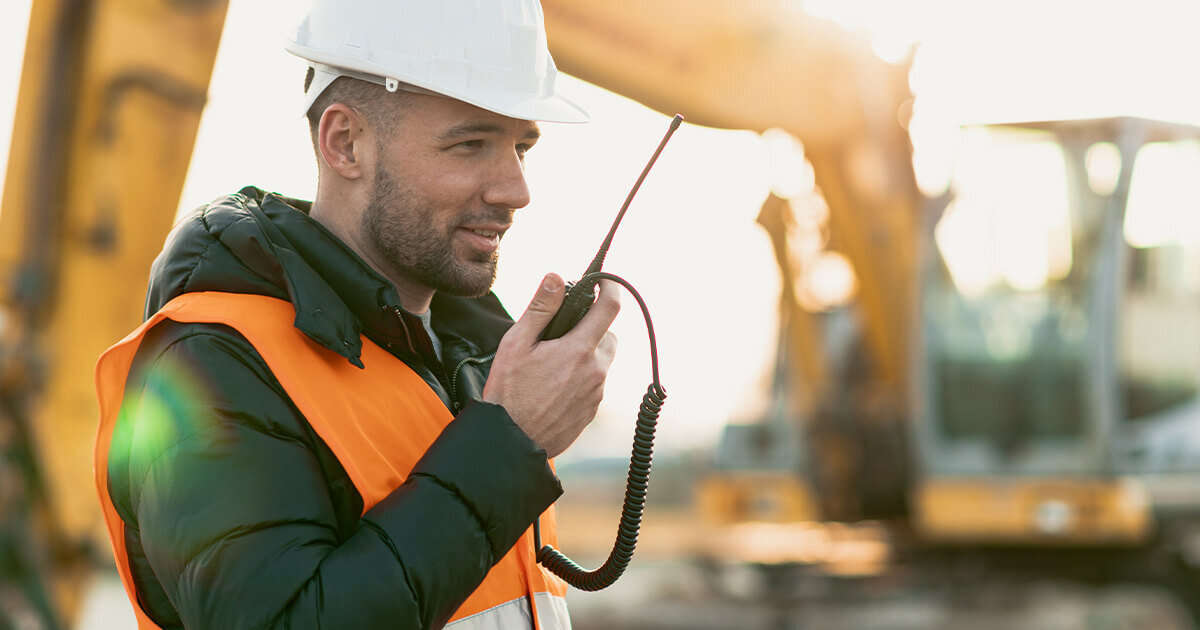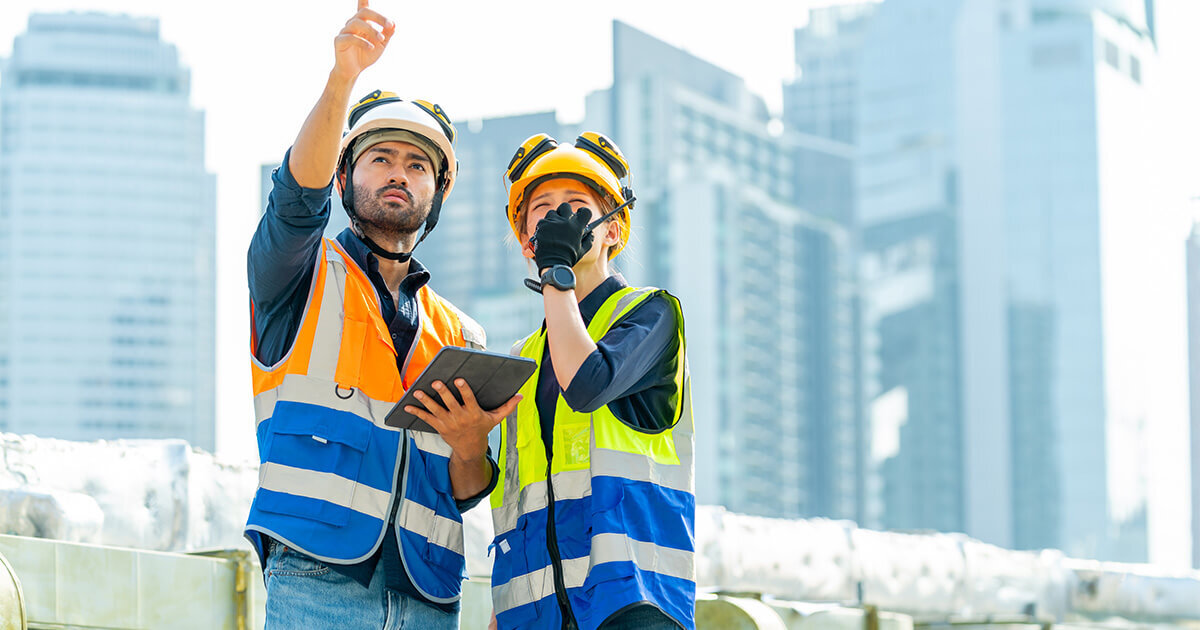
Delays eat profits. When projects fall behind, you lose money and client trust suffers. While you can't control bad weather or permit issues, you can fix many delays that stem from poor communication.
Two-way radios are among the most effective construction communication tools for keeping projects on schedule. They connect everyone right away without hunting for cell service.
No need to take off gloves or worry about rain and dust. Everyone hears the same message at once, cutting down on mix-ups.
Construction sites create tough communication challenges. Heavy machines, power tools, and work noise make it hard to hear. Large sites spread teams far apart. Harsh conditions destroy paper plans and damage phones.
Better communication does more than speed up work. It cuts down accidents when warnings reach everyone fast. It boosts quality when instructions are clear. It helps jobs finish on time, building your reputation in the industry.
The Real Cost of Construction Delays
When a construction project falls behind, the money problems go deeper than what shows on the surface.
Yes, you pay for idle workers and equipment that sits unused, but the chain reaction cuts much further. Research shows major construction projects typically run 20% behind schedule and up to 80% over budget. This translates to thousands of dollars lost each day of delay.
Delays create a domino effect beyond the immediate site. Subcontractors often schedule multiple projects in advance. When your project runs late, it forces them to rearrange their schedules or wait, sometimes at an added cost to you. For specialty trades like electrical and HVAC, one delay in their timeline could push back inspections and create bottlenecks.
Material logistics suffer as well. Suppliers plan deliveries based on projected timelines, but when a job site isn't ready, stored materials become costly problems. Some materials, like concrete or prefabricated parts, may have limited storage options, requiring last-minute solutions that drive up costs. Rushed shipments, extra storage fees, and expedited labor all add up.
Reputation damage is another hidden cost. Clients remember the contractors who miss deadlines. In a competitive industry, this can be the deciding factor when bidding for future jobs. One delayed project can mean lost referrals and fewer repeat customers.
There's also the legal side. Some contracts include penalty clauses for missed deadlines, with financial consequences for every extra day past the agreed completion date. This can lead to direct financial losses and strained client relationships. The ability to maintain seamless communication across a site is one of the most effective ways to prevent these problems.
Common Communication Challenges on Construction Sites
Construction sites make communication difficult by design. The loud noise of machinery, power tools, and site sounds creates a backdrop where normal conversation is very hard without shouting yourself hoarse. This is especially true across larger sites where team members might be hundreds of feet apart.
Physical obstacles make things worse at every turn. Concrete walls, multiple floors, steel structures, and temporary barriers create dead zones where workers become cut off.
How many times have you seen someone waste 20 minutes tracking down a supervisor for a five-second decision? These small delays add up to major schedule impacts over time.
When plumbers, electricians, HVAC specialists, and framers all need to work together in a specific sequence, communication breakdowns create costly bottlenecks. One team's delay spreads through the entire project timeline, affecting all subsequent phases.
Smartphones might appear to be the solution, but they rapidly demonstrate limitations in construction environments. Touchscreens malfunction with gloved hands or in adverse weather conditions. Batteries deplete halfway through shifts, creating unexpected downtime. Devices frequently become damaged, lost, or inoperable in the demanding conditions of construction sites.

How Two-Way Radios Improve Construction Efficiency
Two-way radios cut through these challenges with immediate push-to-talk communication that doesn't waste time with dialing, waiting for rings, or playing phone tag. When a critical decision needs input from someone across the site, the conversation happens right away rather than causing a work stoppage.
Unlike consumer electronics, construction-grade radios are built for abuse. They shrug off dust, water, drops onto concrete, and temperature extremes that would destroy a smartphone within hours. Many models meet military standards for durability – because in construction, equipment failure isn't an option when deadlines loom.
The communication flexibility of radio systems matches construction's diverse needs perfectly. One-to-one private conversations handle sensitive discussions, while one-to-many broadcasts ensure everyone gets critical updates simultaneously. This dual capability streamlines both daily coordination and emergency situations without switching between different communication methods.
Modern two-way radios such as the MOTOTRBO Ion cover impressive distances, with ranges spanning hundreds of feet to several miles depending on the model and environment. This extensive reach maintains connections across sprawling construction sites, inside partially completed structures, and even in traditionally difficult areas like basement levels or elevator shafts where cell service fails completely.
Key Features to Look for in Construction Two-Way Radios
Not all construction communication tools are built for demanding job sites. Choosing the right two-way radio makes all the difference.
The IP (Ingress Protection) rating tells you exactly what abuse a radio can withstand. For construction, don't settle for less than IP67 – meaning complete dust protection and water resistance for up to 30 minutes at one meter depth. This ensures your communication network survives everything from concrete dust to sudden downpours.
Battery life makes or breaks field communication tools. Construction-specific radios offer extended power, typically 12-24 hours of actual use rather than the "standby time" often advertised for consumer products. Look for models with hot-swappable batteries that let workers exchange dead power packs for charged ones without losing connection during critical operations.
The constant background roar of construction sites demands advanced noise-cancellation technology. Superior models filter out the din of heavy machinery, allowing clear voice transmission even standing next to running concrete mixers or generators. This clarity eliminates the frustrating "What did you say?" exchanges that waste time and lead to miscommunications.
Safety features provide value beyond mere convenience. Emergency alert buttons that broadcast instant distress signals, automatic "man down" notifications that trigger if a worker falls, and GPS location tracking capabilities can literally save lives by reducing response time to accidents. These features transform radios from mere communication tools into essential safety equipment.
Implementing Two-Way Radio Systems on Your Site
The best radio equipment fails without proper planning. Start with thorough training that goes beyond basic operation. Set clear rules for which channels handle which types of communication, standard terminology that prevents confusion, and proper radio etiquette that keeps channels clear during busy periods.
Smart channel organization prevents communication traffic jams. Assign specific channels to different trades, reserve others for management-level talks, and always keep a clear emergency channel open for critical safety communications. This structured approach ensures messages reach their intended recipients without getting lost in crosstalk.
Rather than forcing radios into existing workflows, map out where better communication could fix current bottlenecks. Find the handoff points between teams, inspection moments, and decision points where delays typically happen. Target these high-impact areas first to show clear value to skeptical team members.
Consider starting with a limited test before going all-in. A pilot program focusing on one particularly communication-heavy phase of construction lets teams adapt gradually while providing real-world proof of benefits. This approach builds buy-in from actual results rather than promises alone.
Measuring ROI from Improved Communication
The true return on investment from two-way radios shows up in multiple ways across your project timeline. Track time saved during daily coordination activities, reductions in expensive rework caused by miscommunication, and faster problem solving when issues inevitably come up on site. Think of two-way radios like oil in an engine – they don't do the work themselves, but they make everything run smoother.
Compare similar projects with and without radio systems to measure schedule improvements. Many businesses report shorter overall project times after implementing effective radio communication – a major efficiency gain considering the modest investment needed for even high-end radio systems.
Safety improvements add another aspect to the ROI calculation. Better communication leads directly to fewer accidents and near-misses, cutting costs from medical expenses, insurance impacts, and productivity losses following incidents. These safety gains alone often justify the communication investment, with everything else being extra return.
Client satisfaction rises as projects hit milestones consistently and finish with fewer quality issues stemming from poor communication. This enhanced reputation translates to repeat business and referrals – perhaps the most valuable return of all in an industry where relationships drive opportunity.
Start Your Communication Upgrade Today
Don't let poor communication slow down your projects any longer. You don't need to change your entire operation overnight to start seeing benefits. Begin with an honest look at where coordination failures currently impact your projects. Find the specific communication breakdowns that consistently cause delays and target those first for maximum impact.
Many companies offer rental options that let your team try different models under actual working conditions. This hands-on testing helps identify which features truly matter for your specific sites and operations before committing to a particular system.
Set clear success metrics before implementation so you can objectively measure improvements. Whether you track time saved on coordination tasks, reductions in rework, or broader schedule performance, having baseline data makes the benefits concrete rather than theoretical. Construction has enough unavoidable challenges without adding preventable communication failures to the mix.
By implementing robust two-way radio systems with thoughtful protocols, your projects gain the coordination foundation needed to keep teams aligned, responsive, and on schedule – transforming communication from a chronic problem into a competitive advantage. Contact us today for a site assessment and demonstration. Your next on-time, under-budget project is just a radio call away!

